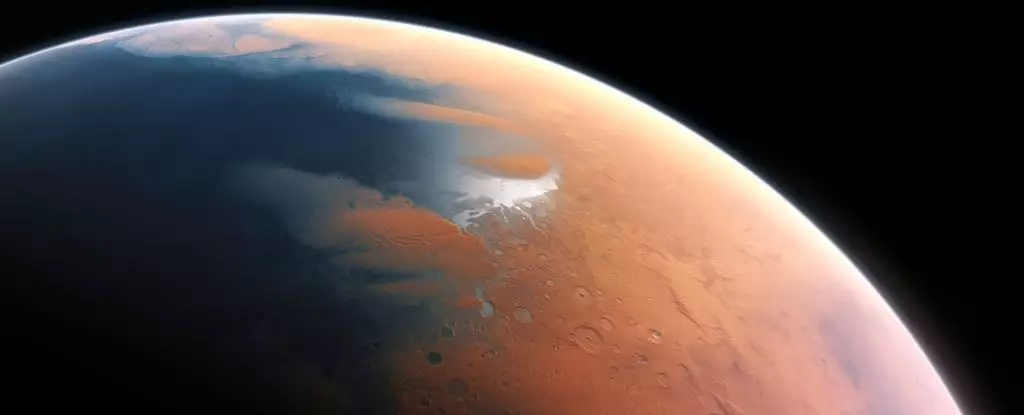As scientists push the frontier of space exploration, interests in Mars have ignited a flurry of research that could revolutionize our understanding of our neighboring planet. Recent studies reveal tantalizing evidence of a significant reservoir of liquid water hidden beneath the Martian surface, nestled within its crust. This revelation sparks not only an intellectual curiosity about Mars’ geological and climatic history but also poses profound implications for the potential for life beyond Earth. Once beleaguered by the notion of a barren desert, Mars now stands at the crossroads of astrobiology and planetary science, heralding a possible rekindling of interest in human exploration of the Red Planet.
The surface of Mars tells a story, littered with remnants of ancient lakes and riverbeds, yet the fate of its water remains a complex puzzle. The intricate dynamics of evaporation, freezing, and mineral-binding, long deemed sufficient to explain the planet’s transformation from a once-wet environment, have now come under scrutiny. Findings from the InSight mission have emerged, shedding light on the nuanced layers of Mars’ crust and revealing a deeper narrative—one that suggests that an incredible quantity of water may still be lurking in the depths.
The InSight Mission: A Breakthrough
NASA’s InSight mission has been a monumental leap in the quest to decipher Mars’ subterranean mysteries. Equipped with a highly sensitive seismometer, the InSight lander recorded seismic waves that have unearthed noteworthy anomalies deep below the surface—specifically within a range of 5.4 to 8 kilometers. The revelation of a “low-velocity layer,” likely saturated with liquid water, exemplifies what can happen when advanced technology meets human curiosity. This reservoir is reminiscent of Earth’s aquifers—voids filled with life-giving water—offering a beacon of hope that echoes Earth’s cherished habitats.
The methodology employed in these findings highlights the precision and innovative nature of modern space exploration. Through meticulous analysis of seismic data generated by meteorite impacts and marsquakes, scientists have reconstructed Martian geological layers akin to mapping the echoes within a vast cave. The contribution of these geological events to our understanding cannot undersell the importance of cross-disciplinary research in fields like seismology and planetary geoscience.
The Great Water Enigma
Prevailing theories regarding Mars’ hydrological transformation suggest that most surface water dissipated into space or became frozen within polar ice caps. However, the newfound hypotheses surrounding the existence of a layered aquifer delve deeper into the planet’s enigmatic history. This assessment posits that the “missing” water, estimated to be enough to cover the planet in an ocean surpassing 700 meters deep, may have quietly seeped into the crust throughout Mars’ tumultuous past. Channels formed due to ancient meteorite impacts could have facilitated this astonishing process, tapping into the potential for warmer subterranean temperatures to maintain water in a liquid state, shielded from the frigid surface conditions.
The staggering volume of water that could be sequestered within these layers offers us a vital connection to Earth’s past and provides fertile ground for contemplating the possibility of extraterrestrial life. Could microbial forms of life have thrived in these subterranean seas akin to their Earthly counterparts? Such implications inspire the imagination, driving forward discussions and research with renewed vigor.
Applications for Humanity and Martian Ecosystems
The implications of uncovering liquid water reservoirs on Mars are both thrilling and pragmatic. While the prospect of finding life, however minute, excites the scientific community, the potential for human utilization of these water sources is equally compelling. Future Mars missions could benefit from these water reserves, facilitating everything from drinking water for astronauts to producing fuel for spacecraft. The motivation to explore and exploit these resources carries implications for long-term human settlement, creating a sustainable presence on the Red Planet.
Additionally, the ethical considerations surrounding the protection of Martian biomes will be paramount. If microbial life does exist in these aquifers, the sanctity of such ecosystems must be preserved against contamination from Earth-originating microbes. This dual responsibility—to explore while safeguarding—will frame our approach to future explorations.
The Need for Continued Exploration
Despite these exciting discoveries, our understanding of Mars remains in its infancy. The knowledge gleaned thus far is confined to a limited section of the planet, necessitating further exploration with dedicated missions employing advanced seismic monitoring tools. The detailed mapping of potential water-rich zones across Mars’ vast expanse opens new avenues for scientific inquiry, hinting at myriad unexplored secrets poised to deepen our connection to the cosmos.
In essence, as we continue listening to the seismic rhythms of Mars, we open ourselves to the possibility that this captivating world is more Earth-like than previously thought. The irony is not lost that a mere 5.4 to 8 kilometers beneath a dusty surface may lie the key to understanding our planetary neighbors, elucidating questions of existence, sustainability, and perhaps, a shared destiny among the stars.


Leave a Reply